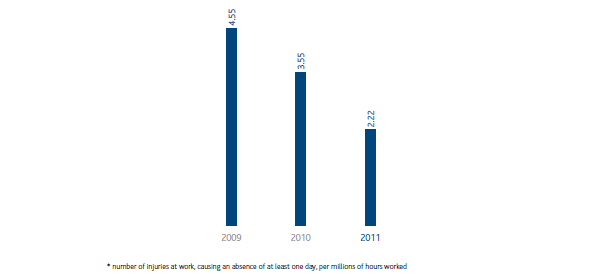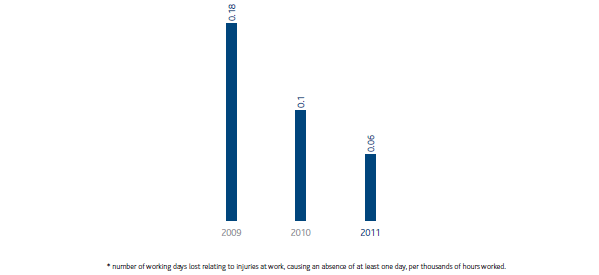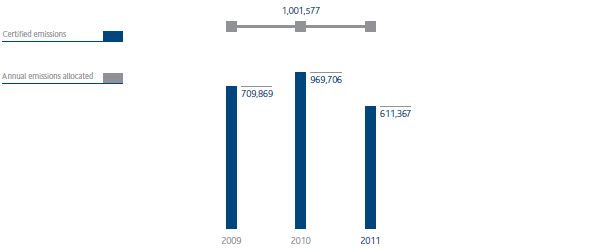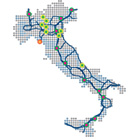By adopting a Health, Safety, Environment and Quality Policy, Snam is assuming a specific commitment to civil society by recognising the essential value of the principles of protection and prevention.
In terms of health, safety, environment and quality, the organisational structure provides for a distinction between the duties of general management, which are centralised within Snam, and the duties of special management, coordination and support for operating units, which are assigned to the individual companies.
In particular, the centralised organisational structures ensure the management of know-how, assist the business units in identifying the most efficient technical and organisational solutions, and define, for all companies, the guidelines, methodologies, standards and operating procedures to be applied. They also take care of the definition, implementation and maintenance of management systems, including by means of technical audits.
The operating companies maintain an internal organisational structure which allows them to operate with an adequate level of decision-making autonomy.
Management systems
Snam has specific certified Management Systems which aim to keep business processes and activities under control, all in the quest for continual improvement of performance.
In 2011 Snam Rete Gas achieved certification for the requirements of the standard for quality management systems, UNI-EN-ISO 9001, for the process of defining the network transportation capacity, confirming the company’s attention to quality, transparency and traceability.
As part of the application of company management systems for the HSEQ issues, Snam continually monitors the implementation and efficacy of the related systems, including by regular auditing. In 2011 in particular, 359 inspections were carried out regarding health, safety and environment and quality.
The table below details the certifications awarded to the various management systems:
| Download XLS (16 kB) |
|
Company |
Activity |
Certification type |
|
Snam Rete Gas |
Compression plants (11 plants) |
ISO 14001 |
|
Snam Rete Gas |
Pipeline network (8 districts, 54 maintenance centres, 32,010 km of pipeline) |
ISO 14001 |
|
Snam Rete Gas |
Dispatching of natural gas |
ISO 9001 |
|
Snam Rete Gas |
Natural gas metering service, transportation network, and management of the design and construction of metering apparatus |
ISO 9001 |
|
Snam Rete Gas |
Company |
OHSAS 18001 |
|
Snam Rete Gas |
Definition of transportation network capacity |
ISO 9001 |
|
STOGIT |
Company |
ISO 14001 |
|
STOGIT |
Natural gas metering and accounting service |
ISO 9001 |
|
GNL Italia |
Regasification plant |
ISO 14001 |
|
ITALGAS |
Company |
ISO 14001-ISO |
Health and safety
The protection of health and safety in the workplace is one of Snam’s primary objectives.
In 2011, in addition to the requirements of Legislative Decree no. 81/08, the Objective Safety project, launched at the end of 2010, continued its significant initiatives which aim to act on the culture of the workforce to improve attitudes, behaviour and personal responsibility with regard to health and safety at work. The project was implemented to further reduce the number of incidents and accidents at work, including by unifying and improving best practices developed by the individual companies.
The project also includes the initiatives “Safety Trophy” and “Zero Accidents Prize”, which are aimed at encouraging all employees to adopt safe and responsible behaviour, through a points-based competition with non-monetary prizes. The first of these initiatives mainly involves the personnel of outlying operating sites, while the second is aimed at all personnel.
Featuring among the new initiatives introduced this year are the Safety Walks, where members of top management, as the active sponsors of the project, meet with Snam personnel to support their activities and to reaffirm, by their presence, the importance of active involvement of the entire corporate structure in achieving effective safety at work.
Internal communication and training act to consolidate knowledge and reinforce attention on the issue. Specifically, the selected channels for communication are as follows: the intranet portal, displays posted at all Snam sites and a new newsletter, created in mid-2011, which provides in-depth information on the issues, risks and tools associated with health and safety in the workplace. The news bulletin, produced in hard copy, is distributed to all personnel of the Snam group.
With regard to safety in connection with contracted labour, special attention was paid to suppliers’ qualifications and, subsequently, to evaluating suppliers through special inspections performed in the work execution phase. Suppliers also increased their involvement in issues of safety through specific awareness meetings.
The measures implemented in recent years have enabled us to obtain good results both at the group level and for the individual companies, as shown by the trend of the following accident indicators.
ACCIDENTS AT WORK - FREQUENCY INDEX (*)
ACCIDENTS AT WORK - SEVERITY INDEX span>(*)
The frequency index for Snam employees stood at 2.22 (-37.5% from 2010) and the severity index at 0.06 (-40% from 2010). Once again in 2011 there were no fatal accidents.
During the course of the year, the commitment to protect the health of employees was reaffirmed by focusing on continually monitoring risk factors identified in the corporate processes and implementing suitable prevention and protection measures. Work environment inspections were carried out in order to evaluate adequate and appropriate working and environmental conditions and to identify possible measures for prevention or improvement. In 2011 around 400 environmental inspections were carried out.
Activities were continued to support specific health protection initiatives, such as cancer prevention and flu vaccination campaigns, bans on smoking in company workplaces, and on the supply of alcohol in company canteens.
For the personnel exposed to specific risk factors we implement regular healthcare surveillance, recording around 2,200 medical visits by the Competent Doctors during the year.
Environmental Protection
Protection of the environment is of primary importance during all phases of Snam operations. The criteria and procedures adopted for the location, design, construction and management of the plants meet high environmental protection requirements.
Snam is committed to providing Italy with a daily source of energy, natural gas, which owing to its chemical and physical properties and its ability to be used in highly efficient technologies in various sectors (civil, industrial and thermoelectric), is able to provide a significant contribution to reducing atmospheric emissions of greenhouse gases (GHG), particles and sulphur oxides. In actual fact, using the same amount of energy, the carbon dioxide (CO2) generated by natural gas consumption is 25-30% less than that produced by oil products and 40-50% less than coal.
The more significant environmental aspects of Snam operations are the temporary use of the soil during the construction of new transportation infrastructures and the atmospheric emissions from the use of gas turbines installed in the gas compression plants (transportation and storage).
When laying pipelines, the route is selected from a variety of alternatives according to environmental impact, transportation safety and technical and economic feasibility considerations. In particular, it seeks to avoid or to minimise the passage through areas of significant natural or cultural interest, archaeological areas, geologically unstable areas and inhabited areas where the construction of new dwellings is anticipated. When laying the pipelines technologies are used that interfere with the surrounding environment as little as possible. Having completed the works, a careful environmental restoration operation is carried out to return the land to its original condition.
During the year the environmental restoration activity concerned primarily regions of northern Italy (Friuli Venezia Giulia, Piedmont, Lombardy) and the South (Calabria, Puglia, Basilicata and Sicily). Restoration works were carried out, along the paths of the pipelines, over a total distance of approximately 235 km, and new trees were planted along 43 km.
During operation, the plants and pipelines periodically undergo inspections and maintenance to ensure very high safety standards. Particular attention is paid to the section of lines that are inspected regularly by vehicles, using helicopters and personnel on foot in order to detect potentially hazardous situations caused, for example, by the works of third parties in the area of the pipelines. Similarly, any land slippage at specific points of the route is also kept under surveillance. The integrity of the pipelines is also inspected by passing devices along them known as “intelligent pigs”, which can detect any faults.
In 2011 around 1,145 km of network were inspected with intelligent pigs and more than 14,000 km using helicopters.
The use of natural gas, which meets almost all of the Snam energy requirement (more than 95%), allows us to minimise sulphur oxides and particle emissions.
To limit the emissions of nitrogen oxides generated by the gas turbines used in the compression plants, specific programmes have been defined over the years to modify the existing turbines and install new units with low emission combustion (DLE) systems both in the gas compression and storage plants. During the year TC4 of the Montesano plant was commissioned, the TC3 turbocompressor at Fiume Treste was renovated to DLE and the modification to low emissions was implemented for the TC1 turbocompressors at Settala, the TC1 at Sabbioncello and the TC1, Messina.
The greenhouse gases emitted into the atmosphere by Snam operations are CO2 and methane (CH4), a primary component of natural gas. The CO2 is a by-product of the combustion process and is directly associated with the consumption of fuels, while the emissions of natural gas, and therefore CH4, derive partly from the normal operation of the plants and partly from the atmospheric emissions due to the connection of new pipelines and maintenance or to accidental events of the transportation and distribution networks.
Snam seeks to minimise its greenhouse gas emissions in its operations by implementing specific containment programmes such as:
- the reduction of natural gas emissions (through the recompression of gas in pipelines, the replacement of pneumatic equipment and the replacement of cast-iron pipes in distribution networks);
- the reduction of power consumption (using specific energy management measures);
- the use of electricity produced from renewable energy sources (through specific purchase contracts and the installation of photovoltaic panels in building construction).
The Snam plants subject to the Emissions trading Directive (2003/87/EC), which establishes the Emissions market for greenhouse gases, are: the 11 gas compression plants and one entry point terminal of Snam Rete Gas, seven Stogit gas compression plants and one liquefied natural gas regasification plant of GNL Italia. In 2011, total CO2 emissions certified by an accredited body according to the provisions of the competent national authority, amounted to 611,367 tonnes, out of a total of 1,001,177 annual shares issued by the Ministry for the Environment, Land and Sea (positive balance of 390,210 shares). For the three-year period 2009-2011, Snam will also be able to count on a financial payment by the competent national authority, to be made in 2013, having exhausted the reserve of shares due to the New Entrant of the Malborghetto Plant (compression unit TC5).
ETS PLANTS CO2 EMISSIONS
(tonnes)
As regards the waste management, in 2011 the regulatory monitoring activity and the proliferation of technical and operational updates of Sistri (Waste Tracking Control System) continued, which was introduced by Ministerial Decree of 17 December 2009. During the year 16 training versions were delivered, which involved around 180 people.
Quality
With regard to sales, in May 2011 ISO 9001 certification was obtained for the process for defining the transportation capacities of the Snam Rete Gas network, with a view to ever-increasing attention to the quality, transparency and traceability of its own procedures and to continual improvement of interactions with its stakeholders.
The project, initiated in the second half of 2010, achieved the objective of obtaining quality certification from an official accredited body starting from the capacity definition published for the thermal year 2011-2012.
This confirmed the quality certification for the natural gas dispatching processes on the transportation network and the gas metering processes of Snam Rete Gas and Stogit.






